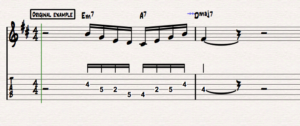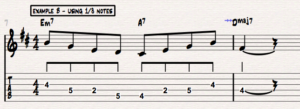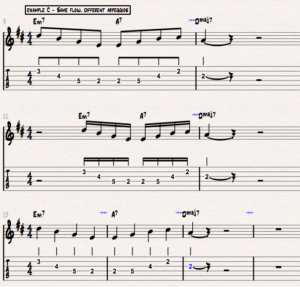Warp Time to Run The Changes
Oct 29, 2017How to Manipulate Time Using Your Jazz Guitar
Welcome to volume three in our series, “Hands-On Jazz Guitar.” This new episode is all about “Warp Time Using Your Jazz Guitar.”
This series aims for you to learn how to play solid jazz lines. Working through jazzguitarlessons.net transcriptions, we’re finding some great and interesting ideas for you. Today, we take a straightforward line, then find ways to manipulate it using rhythm. We start by learning the line, then we’ll explore new ways to use it.
Download ALL of the licks here: "How to Manipulate Rhythms"
Join our Community here.
This lesson has four steps
Step One : Learn the line and get it in your fingers.
Step Two : Present the rhythmic concept behind this lesson.
Step Three : Explore creative ways of putting the rhythmic concept to work.
Step Four : Use the idea to improvise!
The first step, we will be playing the “original lick” many times so you feel comfortable with it.
Origin
Today’s line is from the April 2016 issue of our Tune of The Month Club, “Body and Soul”.
This is the “Original Lick”.

The lick uses 16th notes, which are usually very quick-sounding. In this case, because the tempo is slow, the 16th notes do not sound so fast.
We’ll begin by playing the line at a slower tempo, so you can follow. Keep studying the example on your screen, and work slowly at first.
Let us play the line in different tempos. We will do three progressions; first is the 50% of the original speed, second is 80% of the original speed and finally the line at 100% or full speed. Once you’ve got the lick under your fingers, move on!
When you have the line under your fingers, understanding ways to get creative with it is your next step. Listen to the idea many times to understand it with your ears. Then study the idea with your eyes.
The Lesson
Without changing the actual notes you play, you can add and subtract value to the rhythm of the notes to create a new feel. For example, because we’re starting with a 16th-note value, we can try doubling that value to make each 16th note into an 8th note. The result is a line that is twice as long, and can immediately be used in situations where the chord progression is stretched out over a longer number of beats. A quick look at Example B shows what I’m talking about.
You can try this with different note values. Replacing a 16th note with a quarter note, for example, will give a another very different and useful result!
If music theory is confusing for you, it’s no problem! You can learn. Our course “Jazz Guitar Improv 101” will get you to started. You’ll learn some great scales, and important concepts about chords and harmony. Most importantly, you’ll come away with some solid know-how about jazz music.
Let’s move on to Step Three. Here we’ll create three new lines using this lesson’s concept. Challenge yourself to think about the idea, and explore new options. I find that writing out potential ideas helps a lot, and you can give it a try too. Here are my three new lines. You’ll find the full PDF notation with TABS for my three examples by clicking on the links found in the blog post, which you’ll find in the description below.
More Examples
Example A is expanded from the original 16th-note idea, becoming a quarter-note version of the line. It still contains the exact same notes; but you’ll notice that the chord progression is now expanded over two measures.

This length of chord progression in jazz is very common, making this idea very useful!
Example B uses the same concept as Example A. The difference is, instead of using quarter notes, we use 8th notes as our main rhythm. Our chord progression is a bit shorter too, changing chords every two beats instead of each bar.

Example C. My final idea uses all three of the rhythms we used earlier. The twist this time is that I’ve changed the notes I’m using.
All in all, you can try taking one of two paths. The first -- change the rhythm. The second -- change the notes! With these two variables, you will create PLENTY of new ideas.

I hope you’ve enjoyed the lesson! Remember, take your time when learning the line and the theory. These ideas will be soon be a solid part of your playing for years to come!
Download ALL of the licks here: "How to Manipulate Rhythms"
Join our Community here.










